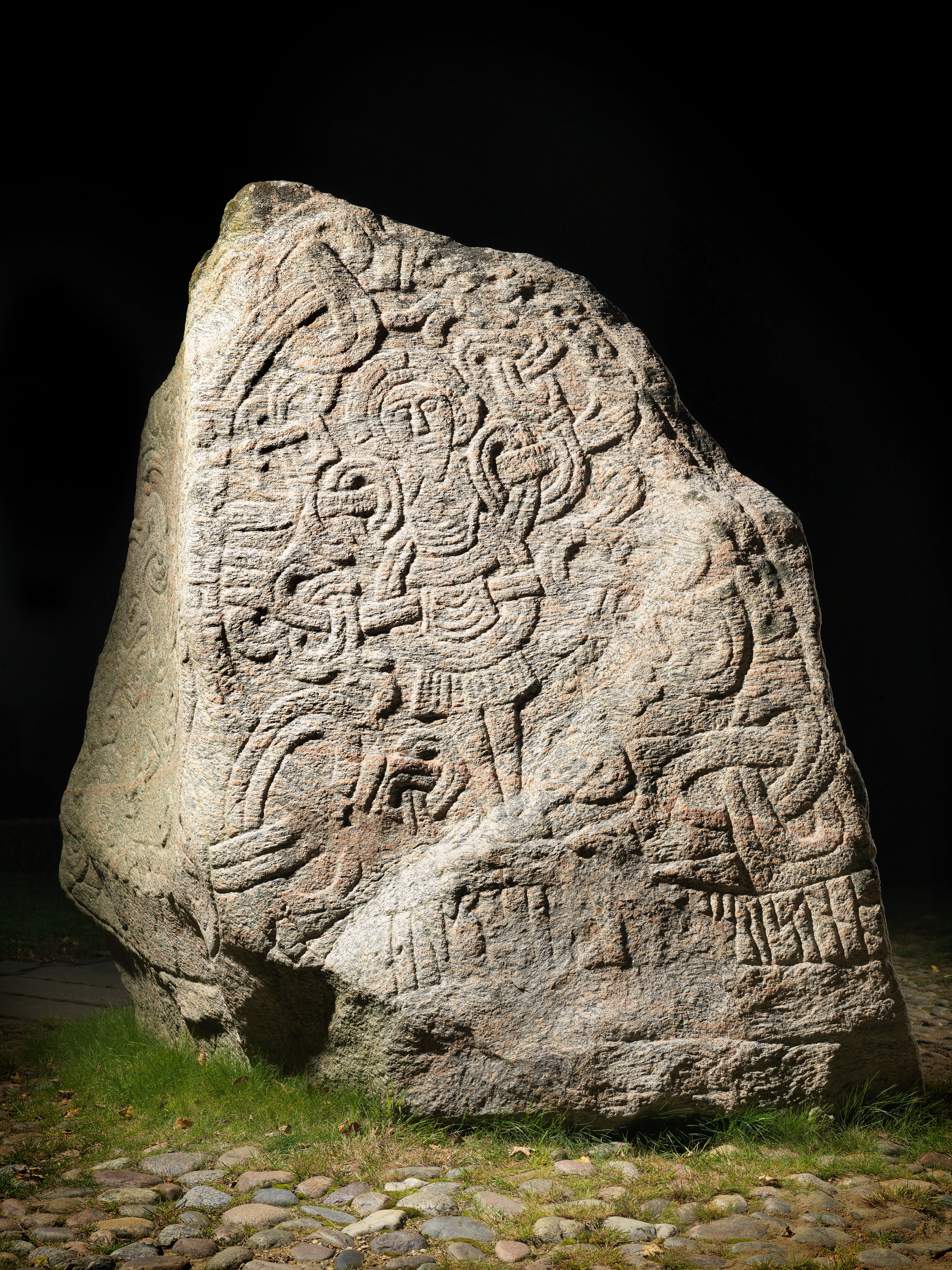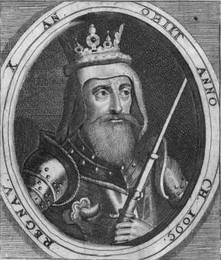|
Valdemar The Young
Valdemar the Young () ( – 28 November 1231) was a Junior King of Denmark from 1215 until his death. Valdemar was the eldest son and co-ruler of King Valdemar II of Denmark by his first wife, Dagmar of Bohemia. He did not outlive his father so was never a sole monarch. He is sometimes referred to as Valdemar III for example his tombstone reads in la, Waldemarus Tertius Rex Daniae, Filius Waldemari Secundi "Valdemar the Third, King of Denmark, son of Valdemar the Second". Although Valdemar III is more commonly used to denote a later king, Valdemar of Schleswig. Early life Valdemar was born in 1209. He was the eldest child from his father's first marriage. His mother, Queen Dagmar, died in childbirth in 1212, leaving her husband a widower with a young son; she had been very popular among the Danish people due to her piety and kindness to the common people. King Valdemar remarried two years later to Berengaria of Portugal. From this marriage Valdemar the Young gained four half- ... [...More Info...] [...Related Items...] OR: [Wikipedia] [Google] [Baidu] |
King Of Denmark
The monarchy of Denmark is a constitutional political system, institution and a historic office of the Kingdom of Denmark. The Kingdom includes Denmark proper and the autonomous administrative division, autonomous territories of the Faroe Islands and Greenland. The Kingdom of Denmark was already consolidated in the 8th century, whose rulers are consistently referred to in Franks, Frankish sources (and in some late Frisians, Frisian sources) as "kings" (). Under the rule of King Gudfred in 804 the Kingdom may have included all the major provinces of medieval Denmark. The current unified Kingdom of Denmark was founded or re-united by the Vikings, Viking kings Gorm the Old and Harald Bluetooth in the 10th century. Originally an elective monarchy, it became hereditary monarchy, hereditary only in the 17th century during the reign of Frederick III of Denmark, Frederick III. A decisive transition to a constitutional monarchy occurred in 1849 with the writing of the first democrat ... [...More Info...] [...Related Items...] OR: [Wikipedia] [Google] [Baidu] |
Schleswig
The Duchy of Schleswig ( da, Hertugdømmet Slesvig; german: Herzogtum Schleswig; nds, Hartogdom Sleswig; frr, Härtochduum Slaswik) was a duchy in Southern Jutland () covering the area between about 60 km (35 miles) north and 70 km (45 mi) south of the current border between Germany and Denmark. The territory has been divided between the two countries since 1920, with Northern Schleswig in Denmark and Southern Schleswig in Germany. The region is also called Sleswick in English. Unlike Holstein and Lauenburg, Schleswig was never a part of the German Confederation. Schleswig was instead a fief of Denmark, and its inhabitants spoke Danish, German, and North Frisian. Both Danish and German National Liberals wanted Schleswig to be part of a Danish or German national state in the 19th century. A German uprising in March 1848 caused the First Schleswig War which ended in 1852. The Second Schleswig War (1864) ended with the three duchies being governed jointly by Austri ... [...More Info...] [...Related Items...] OR: [Wikipedia] [Google] [Baidu] |
Dukes Of Schleswig
The following is a list of jarls and dukes, who ruled over Schleswig respectively Southern Jutland (Sønderjylland). First jarls/dukes Houses of Estridsen and Schauenburg (1080–1460) House of Oldenburg In 1864, following the Second Schleswig War, the Duchy of Schleswig-Holstein became an occupied territory of the German Confederation and two years later, following the Austro-Prussian War, part of the new Prussian Province of Schleswig-Holstein. See also *List of Danish monarchs *List of rulers of Schleswig-Holstein The following is a list of rulers (usually dukes) who ruled both Schleswig and Holstein, starting from the first Holstein count who received Schleswig, until both territories were annexed by the Kingdom of Prussia in 1866; and afterwards, titular ... Notes {{DEFAULTSORT:Schleswig, Dukes Of Lists of Danish people Lists of monarchs Dukedoms of Germany People from the Duchy of Schleswig * Lists of dukes ... [...More Info...] [...Related Items...] OR: [Wikipedia] [Google] [Baidu] |
List Of Danish Monarchs
This is a list of Danish monarchs, that is, the kings and queens regnant of Denmark. This includes: * The Kingdom of Denmark (up to 1397) ** Personal union of Denmark and Norway (1380–1397) * The Kalmar Union (1397–1536) ** Union of Denmark, Norway and Sweden (1397–1523) ** Union of Denmark and Norway (1523–1536/1537) * The United Kingdoms of Denmark–Norway (1536/1537–1814) * The Kingdom of Denmark (1814–present) ** Iceland (since the union between Denmark and Norway in 1380; independent kingdom in a personal union with Denmark 1918–1944; a sovereign republic since 1944) ** Greenland (since the union between Denmark and Norway in 1380; effective Danish–Norwegian control began in 1721; integrated into the Danish realm in 1953; internal home rule introduced 1979; self-determination assumed in 2009; Greenland has two out of 179 seats in the Danish parliament Folketinget) ** Faroe Islands (since the union between Denmark and Norway in 1380; County of Denmark 1816– ... [...More Info...] [...Related Items...] OR: [Wikipedia] [Google] [Baidu] |
House Of Estridsen
The House of Estridsen was a dynasty that provided the kings of Denmark from 1047 to 1412. The dynasty is named after its ancestor Estrid Svendsdatter. The dynasty is sometimes called the ''Ulfinger'', after Estrid's husband, Ulf Jarl. The dynasty also provided three of the rulers of Sweden in the years 1125–1412. Their family coat of arms became the coat of arms of Denmark and therefore influenced the coat of arms of Tallinn and the coat of arms of Estonia. The Royal Court of Denmark does not differentiate between different royal houses among the early Danish kings, but uses the term "the descent of Gorm the Old" about all the pre-Oldenburg monarchs. Background The name of the Estridsen dynasty recalls their acquisition of the Danish crown through the marriage of Ulf the Earl to Estrid Svendsdatter of the House of Knýtlinga, daughter of Sweyn Forkbeard and sister of Cnut the Great. Later genealogies (introduced by the Danish historian Jakob Langebek in the 18th century)Ja ... [...More Info...] [...Related Items...] OR: [Wikipedia] [Google] [Baidu] |
Ringsted
Ringsted is a city located centrally in the Danish island of Zealand. It is the seat of a municipality of the same name. Ringsted is situated approximately 60 km from Copenhagen. Tourism and transport Ringsted is one of Denmark's busiest transit cities. The city is located in the very middle of Zealand, connecting both the southern parts of Zealand as well as Funen and Jutland with the Copenhagen area. * Danish Tramway Museum of Skjoldenæsholm, near Jystrup. * Ringsted Station, served by both DSB domestic trains and international (EuroCity) services to Hamburg: frequent services to Copenhagen, Nykøbing Falster and Odense, although not all trains to Jutland stop at Ringsted — the bus station is in front of the railway station. * St. Bendt's Church — a Romanesque, former Benedictine, abbey church containing numerous tombs of medieval Danish royalty. History Ringsted was the site of ''Sjællands Landsting'' (lit. ''Zealand's county thing'') during the Middle Ages, w ... [...More Info...] [...Related Items...] OR: [Wikipedia] [Google] [Baidu] |
Ancient Diocese Of Viborg
The former Diocese of Viborg () was a Roman Catholic diocese in Denmark. It was established in 1065 and was dissolved in 1536 during the Protestant Reformation."Diocese of Viborg" ''''. David M. Cheney. Retrieved February 29, 2016"Diocese of Viborg" ''GCatholic.org''. Gabriel Chow. Retrieved February 29, 2016 The region was originally part of the |
Ribe
Ribe () is a town in south-west Jutland, Denmark, with a population of 8,257 (2022). It is the seat of the Diocese of Ribe covering southwestern Jutland. Until 1 January 2007, Ribe was the seat of both a surrounding Ribe Municipality, municipality and Ribe County, county. It is now part of the enlarged Esbjerg Municipality in the Region of Southern Denmark. History The town was a center of commercial activity in the early 8th century, and this may have originated with royal influence. Coins may have been struck there in 720. Whichever king was involved in the digging of the Kanhave Canal may have been involved in the establishment of Ribe also. Trade contacts were mostly with Frisia and England. Of the over 300 sceatas found in Denmark, 216 come from in or around Ribe, most of them the Wodan type, and these were likely minted in Ribe in the early eighth century. The Ancient Diocese of Ribe was established in 948 with the consecration of Leofdag of Ribe as its first bishop. Earl ... [...More Info...] [...Related Items...] OR: [Wikipedia] [Google] [Baidu] |
Afonso II Of Portugal
Alphons (Latinized ''Alphonsus'', ''Adelphonsus'', or ''Adefonsus'') is a male given name recorded from the 8th century (Alfonso I of Asturias, r. 739–757) in the Christian successor states of the Visigothic kingdom in the Iberian peninsula. In the later medieval period it became a standard name in the Monarchy of Spain, Hispanic and kingdom of Portugal, Portuguese royal families. It is derived from a Gothic name, or a conflation of several Gothic names; from ''*Aþalfuns'', composed of the elements ''aþal'' "noble" and ''funs'' "eager, brave, ready", and perhaps influenced by names such as ''*Alafuns'', ''*Adefuns'' and ''*Ildefonsus, Hildefuns''. It is recorded as ''Adefonsus'' in the 9th and 10th century, and as ''Adelfonsus'', ''Adelphonsus'' in the 10th to 11th. The reduced form ''Alfonso'' is recorded in the late 9th century, and the Portuguese form ''Afonso'' from the early 11th. and ''Anfós'' in Catalan from the 12th Century until the 15th. Variants of the name ... [...More Info...] [...Related Items...] OR: [Wikipedia] [Google] [Baidu] |
Christian Emil Andersen 1843 Death Of Valdemar The Young At Refsnes IMG 5805
Christians () are people who follow or adhere to Christianity, a monotheistic Abrahamic religion based on the life and teachings of Jesus Christ. The words ''Christ'' and ''Christian'' derive from the Koine Greek title ''Christós'' (Χριστός), a translation of the Biblical Hebrew term ''mashiach'' (מָשִׁיחַ) (usually rendered as ''messiah'' in English). While there are diverse interpretations of Christianity which sometimes conflict, they are united in believing that Jesus has a unique significance. The term ''Christian'' used as an adjective is descriptive of anything associated with Christianity or Christian churches, or in a proverbial sense "all that is noble, and good, and Christ-like." It does not have a meaning of 'of Christ' or 'related or pertaining to Christ'. According to a 2011 Pew Research Center survey, there were 2.2 billion Christians around the world in 2010, up from about 600 million in 1910. Today, about 37% of all Christians live in the A ... [...More Info...] [...Related Items...] OR: [Wikipedia] [Google] [Baidu] |
Orlamünde
Orlamünde () is a small town in the Saale-Holzland district, in Thuringia, Germany. It is part of the ''Verwaltungsgemeinschaft'' ("collective municipality") Südliches Saaletal. Geography The town centre stretches along the steep banks of the Saale river at the confluence with the Orla, approximately south of Jena. With a population of about 1,100 it is one of the smallest towns in Thuringia. Orlamünde station is a stop on the Saal Railway line from Großheringen to Saalfeld. Frome here the Orla Railway runs along the Orla river to Pößneck. History Located at the eastern rim of the early medieval Duchy of Thuringia, Orlamünde was the site of a fortress at the border with lands of the Polabian Slavs and the Sorbian March. The settlement itself was first mentioned in a 1039 deed. The estates were acquired by Count Otto of Weimar about 1062, who also ruled as Margrave of Meissen. He and his descendants went on to rule as Counts of Weimar-Orlamünde until the dynasty bec ... [...More Info...] [...Related Items...] OR: [Wikipedia] [Google] [Baidu] |






